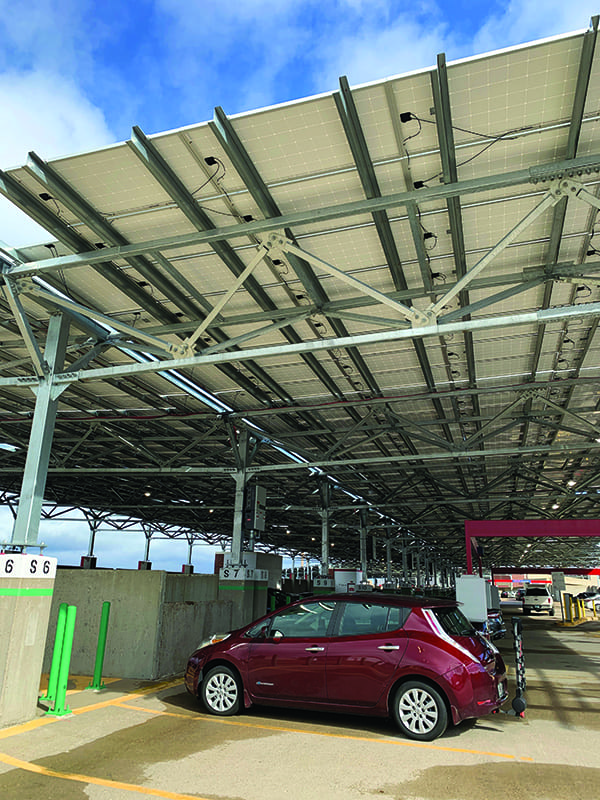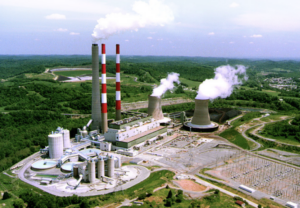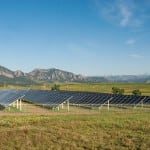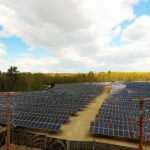Community solar refers to local solar facilities shared by multiple subscribers who receive credit on their electricity bills for their share of the power produced. Community solar allows homeowners, renters, and businesses to have equal access to the benefits of solar energy generation regardless of the physical attributes or ownership of their homes or businesses. The option is proving to be wildly popular.
As the U.S. solar industry entered a phase of rapid growth over the last decade, there was a vast underserved market of households and businesses that could not be served by traditional rooftop solar. Community solar emerged to fill that gap and serve customers looking for access to the benefits of solar without having to install it directly on their property. Instead of worrying about whether they had enough sunlight exposure, access to financing, or any property at all, customers could instead “subscribe” to a share of a larger off-site community solar facility and get credit for their share of the power production on their utility bill.
This shared solar concept was just starting to be tested at the beginning of the decade, but now the Solar Energy Industries Association (SEIA) says that 40 states hosted at least one community solar project through 2018 and that at least 19 states plus the District of Columbia have community solar policies in place. Together these efforts resulted in 1,523 MW of community solar being installed through 2018.
The growth and success of community solar in recent years has been accompanied by growing pains, programmatic evolution, and innovation. Some community solar programs have moved through the heady chaos of their early boom years toward more focused and stable growth, and new programs are attempting to apply the lessons learned—focusing on finding the right balance for program and project size, determining appropriate compensation levels, and providing access to all customers.
Compensation
The early 2010s featured battles in several states over the future of net-metering in the face of rapid expansion of rooftop solar and over flat or declining utility load. Many insiders were concerned about a utility “death spiral” caused by dwindling sales and rising rates. Community solar and its innovative compensation models forged a much-needed third path that included the utility as a central player in the solar boom. Community solar’s three-party relationship allows the utility to keep and invoice the customer for electricity used while also providing credits to customers for their shares of generation from an off-site solar facility owned by a solar company.
While the demands of customers and interests of market participants created space and opportunity for community solar to grow, its ultimate success depends on pricing. Some states experimented with compensation structures that relied heavily on the sales of renewable energy certificates (RECs). Xcel Energy in Colorado, which uses a bid process for its REC contracts, even tested the market tolerance for negative REC prices in the middle of the decade.
 |
|
1. Community solar projects can be installed in a variety of beneficial locations, helping utilities build a stronger, more distributed and resilient electric grid. Courtesy: Stoel Rives |
Other states continued to provide incentives to encourage solar development. New York includes an incentive system paired with a value stack rate that can include additional payment for locating solar in beneficial locations on the grid (Figure 1) or for providing other desired benefits. Similar efforts to credit shared solar for the precise services it provides have emerged across the country from New York to Oregon, but the first state to create such a new compensation model was Minnesota.
When Xcel Energy opened its community solar program in Minnesota in late 2014, it offered bill credits based on a modified retail rate. The response was a rush from both solar developers and subscribers to enroll, and then subsequent battles over the overall size and costs of the program. By the end of the decade, the Minnesota program had transitioned fully to a value-of-solar rate that added up all of the costs and benefits of distributed solar.
A well-constructed value-of-solar rate would in principle be cost-neutral for non-participating utility ratepayers. Through the course of this shift, stakeholders engaged in robust debate about the costs and benefits of solar, considered additional “adders” to the rate to ensure access to a broader range of subscribers, and engaged in annual recalculations and methodological changes aimed at achieving fairness and rate stability. While refinement of the value-of-solar rate remains a work in progress, overall the rate is working as designed by providing a framework to evaluate and rebalance the myriad costs and benefits of solar on an ongoing basis.
Size Limits
 |
|
2. Sara Bergan (left) and Sarah Johnson Phillips (right) are pictured here standing in front of photovoltaic panels at a community solar garden in Minnesota. Courtesy: Stoel Rives |
As a distributed generation product, community solar is naturally limited in size to about 20 MW or the size that can be reliably accommodated on a utility’s distribution grid (Figure 2). Most programs have negotiated harder project and program size caps. Minnesota is a notable exception in that the implementing statute requires the overall program to remain uncapped. Although the statute limits each project to 1 MW, it is silent on how close together 1-MW projects could be. As a result, Minnesota initially appeared to allow unlimited co-location of 1-MW projects in an uncapped program—a combination that quickly led to a queue of more than 2 GW of applications. This flood of applications resulted in years of administrative litigation to establish rules aimed at prohibiting “co-location” but that in practice are ambiguous, continually evolving, and difficult for solar developers to navigate.
Perhaps with Minnesota’s difficult early experience in mind, the Adjustable Block Program in Illinois anticipated the initial large volume of applications relative to the limited volume of REC contracts available for community solar projects by planning a lottery. The first lottery was held in April 2019 and selected 112 community solar projects with about 215 MW of capacity, which was only about 12% of project applicants. The results left hundreds of projects, all of which were required to have completed substantial development work in order to be eligible for the lottery, in limbo.
While the lottery system might have provided faster certainty than Minnesota’s years-long process of right-sizing its program, the results for developers were, by design, random and harsh for unselected projects. Accordingly, the lottery process, handling of the waitlist, and future selection continue to be subject to challenge and debate. Although Illinois may have successfully applied some lessons learned from Minnesota by setting clear co-location rules upfront, it may not have solved the conundrum of balancing program size limits with a high volume of applications.
While there may not be a perfect way to manage the high interest that any new community solar program with reasonably desirable compensation is likely to attract, experiences in recent years are informative for designing programs for long-term success. But permanently established programs with clear rules upfront for project size and either open tariff enrollment or a generous annual cap could create the type of certainty that would allow developers to make long-term investments in a market and develop a pipeline of projects over time.
Access for All
The basic promise of community solar is not just to encourage solar development but also to give all utility customers access to the benefits of solar energy. Most community solar programs acknowledge a need for diversity among subscribers and thus include minimum and maximum limits on the amount of generation allocated to individual subscribers as well as requirements for the number and type of subscribers each project must have. In theory, these requirements often allow for local businesses to provide anchor subscriptions to aid in stability and financeability, while also allowing room for smaller businesses and residential subscribers to participate in a shared solar project.
Ultimately, however, opportunities for residential subscribers to participate depend on the economics of a project and the project financier’s underwriting requirements. Solar debt and tax equity providers have become increasingly comfortable with community solar in general, as non-utility offtakers become more common in the industry overall, and service providers have developed their capabilities and track records in managing residential subscribers.
The bill credit compensation for residential projects, however, has not necessarily tracked the higher administrative and financing costs of residential projects. As a result, several states have experimented with pilot programs, carveouts, or rate adders aimed at including harder-to-reach residential and low-income subscribers.
For example, in Colorado at least 5% of a project’s generation must be allocated to income-qualified subscribers, the Solar Massachusetts Renewable Target (SMART) Program provides higher incentives for projects benefiting low-income customers, and Minnesota has authorized a bill credit adder for 2019 and 2020 residential community solar projects. While it is not clear yet which, if any, of these approaches will establish sustainable long-term opportunities for residential and low-income subscribers that developers find workable, the nature of community solar and the demonstrated interest in serving these customers by a range of stakeholders suggest that broadening access to community solar will be an important focus in the coming decade.
Looking Ahead
As recently as five years ago, community solar was a largely novel concept and it was unclear whether it would ever be more than a niche part of the market. Heading into 2020, interest in community solar projects remains strong and increasing. SEIA predicts that the community solar market could expand by as much as 3.5 GW in the next five years. In its first decade, community solar has:
- ■ Jumpstarted solar industries in places that had virtually no solar development at the beginning of the decade.
- ■ Populated suburban and rural communities with local 1-, 2-, and 5-MW power plants that are decentralizing generation and providing infrastructure for future grid resilience.
- ■ Innovated new compensation models that account for a broad range of costs and benefits, and ultimately bring savings to participants without shifting costs to other utility customers—a goal that has long eluded the electric generation sector.
- ■ Engaged a diverse cross-section of stakeholders in support of solar, as project subscribers and hosts, in the larger conversation about how the electricity serving their local communities should be produced.
Community solar’s innovations in compensation structures, financial models, and community engagement have set it on a path toward growth and maturity for its second decade. Successful programs serve as examples for the electric sector as it modernizes and continues its transition to carbon-free resources, and to serving wider swaths of the economy and more engaged customers. ■
—Sarah Johnson Phillips is a partner in Stoel Rives’ Energy Development practice group and leads the firm’s Solar Working Group, and Sara Bergan is an attorney in Stoel Rives’ Energy Development practice group.









